These archive pages are provided in order to make it easier for you to find items
that you remember seeing on the Airplanes and Rockets homepage. Of course probably
the easiest way to find anything on the website is to use the "Search AAR" box at
the top of every page.
1 |
2 |
3 |
4 |
5 |
6 |
7 |
8 |
9 |
10 |
11 |
12 |
13 |
14 |
15 |
16 |
17 |
18 |
19 |
20
21 |
22 |
23 |
24 |
25 |
26 |
27 |
28 |
29 |
30 |
31 |
32 | 33
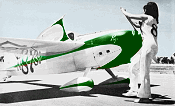 Author Don Berliner claims in this April
19711 issue of American Aircraft modeler magazine that, "[The Owl Racer] is the easiest
racer to model for RC pylon." Curiously, given that claim, no plans were published
for it, but there are 3-views. Designer George Owl (I kid you not) applied knowledge
gained from the School of Hard Knocks in the field of airplane racing on top of
his ample experience with "brains-and-slide-rule" design to create this winning
craft. Did you catch that? "Brains-and-slide-rule." Is that Flo from Progressive
Insurance starting the airplane? Author Don Berliner claims in this April
19711 issue of American Aircraft modeler magazine that, "[The Owl Racer] is the easiest
racer to model for RC pylon." Curiously, given that claim, no plans were published
for it, but there are 3-views. Designer George Owl (I kid you not) applied knowledge
gained from the School of Hard Knocks in the field of airplane racing on top of
his ample experience with "brains-and-slide-rule" design to create this winning
craft. Did you catch that? "Brains-and-slide-rule." Is that Flo from Progressive
Insurance starting the airplane?
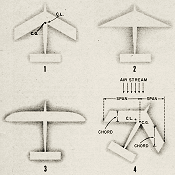 On a whole, free flight fliers seem to have
always been way ahead of the aerodynamic knowledge curve than control line fliers
and radio control fliers - especially when it comes to competition. All modelers
are concerned with the basics of stable flight by building straight airframes with
the proper center of gravity, but when you have some real-time force being applied
to correct for imperfect trim, twisted wings, wind gusts, it is usually possible
to obtain acceptable flights. The centrifugal force of a control line plane flying
in circles, constrained by the counter poise (centripetal force) of the control
lines, and the movable elevators allows the pilot to keep the model on course. Radio
control with at least elevator and rudder and/or aileron can, with the input of
a skilled pilot, compensate for a host of aerodynamic perturbations that would otherwise
upset the flight path. Author Donald Foote in this "A Mechanical
Brain for Catching Thermals" article from the 1956 Annual edition of Air
Trails magazine does a great job of imparting knowledge on how to configure
a free flight model to seek out and exploit thermals. He explains the physics behind
a swept wing's ability to automatically turn toward rising air... On a whole, free flight fliers seem to have
always been way ahead of the aerodynamic knowledge curve than control line fliers
and radio control fliers - especially when it comes to competition. All modelers
are concerned with the basics of stable flight by building straight airframes with
the proper center of gravity, but when you have some real-time force being applied
to correct for imperfect trim, twisted wings, wind gusts, it is usually possible
to obtain acceptable flights. The centrifugal force of a control line plane flying
in circles, constrained by the counter poise (centripetal force) of the control
lines, and the movable elevators allows the pilot to keep the model on course. Radio
control with at least elevator and rudder and/or aileron can, with the input of
a skilled pilot, compensate for a host of aerodynamic perturbations that would otherwise
upset the flight path. Author Donald Foote in this "A Mechanical
Brain for Catching Thermals" article from the 1956 Annual edition of Air
Trails magazine does a great job of imparting knowledge on how to configure
a free flight model to seek out and exploit thermals. He explains the physics behind
a swept wing's ability to automatically turn toward rising air...
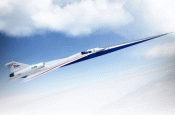 "The X-59, part of NASA's Quesst mission,
is undergoing painting at Lockheed Martin. This aircraft aims to make supersonic
flight quieter and more acceptable for overland travel. NASA's
X-59 quiet supersonic aircraft continues to make progress, most recently moving
to the paint barn at Lockheed Martin Skunk Works' facility in Palmdale, California.
The X-59's paint scheme will include a mainly white body, a NASA 'sonic blue' underside,
and red accents on the wings. The paint doesn't just add cosmetic value. It also
serves a purpose - the paint helps to protect the aircraft from moisture and corrosion
and includes key safety markings to assist with ground and flight operations. The
aircraft made the move to the paint barn on November 14, 2023. Once it is painted,
the team will take final measurements of its weight and exact shape to improve computer
modeling..." "The X-59, part of NASA's Quesst mission,
is undergoing painting at Lockheed Martin. This aircraft aims to make supersonic
flight quieter and more acceptable for overland travel. NASA's
X-59 quiet supersonic aircraft continues to make progress, most recently moving
to the paint barn at Lockheed Martin Skunk Works' facility in Palmdale, California.
The X-59's paint scheme will include a mainly white body, a NASA 'sonic blue' underside,
and red accents on the wings. The paint doesn't just add cosmetic value. It also
serves a purpose - the paint helps to protect the aircraft from moisture and corrosion
and includes key safety markings to assist with ground and flight operations. The
aircraft made the move to the paint barn on November 14, 2023. Once it is painted,
the team will take final measurements of its weight and exact shape to improve computer
modeling..."
 Ask any American what is his all-time favorite
World War II fighter aircraft and the answer will most likely be the P-51 Mustang.
It's sleek lines, rocket-like speed, and the guttural roar of its 12-cylinder engine
creates a demanding presence whether in a museum or on an airshow flight line. That
same person would also probably name the AT-6 Texan as his favorite trainer of the
era, and the B-25 Mitchell as his favorite bomber. What do all three have in common?
They were all designed and manufactured by North American Aviation. At the helm
of the company during the era was James Howard "Dutch" Kindelberger. This story
from a 1949 edition of The Saturday Evening Post magazine takes a look
at the man behind those legendary aircraft, and gives a singularly good example
of how management of a production facility should not panic and take to "throw it
at the wall and see if it sticks" approach... Ask any American what is his all-time favorite
World War II fighter aircraft and the answer will most likely be the P-51 Mustang.
It's sleek lines, rocket-like speed, and the guttural roar of its 12-cylinder engine
creates a demanding presence whether in a museum or on an airshow flight line. That
same person would also probably name the AT-6 Texan as his favorite trainer of the
era, and the B-25 Mitchell as his favorite bomber. What do all three have in common?
They were all designed and manufactured by North American Aviation. At the helm
of the company during the era was James Howard "Dutch" Kindelberger. This story
from a 1949 edition of The Saturday Evening Post magazine takes a look
at the man behind those legendary aircraft, and gives a singularly good example
of how management of a production facility should not panic and take to "throw it
at the wall and see if it sticks" approach...
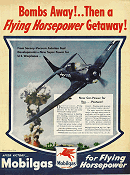 Throughout World War II, American companies
produced lavish, full-color advertisements for magazines to let the public know
how the war effort was being aided by their products. Part of the motivation was
probably to ease the suffering most people were experiencing through rationing of
gasoline, food staples like flour and sugar (and coffee), and the scarcity of new
products and replacement parts as priority was given to supplying our military's
efforts to beat back and defeat the Communist, Socialist, Nazi regimes across Europe,
Africa, and the South Pacific.
Mobilgas, Mobileoil,
and other such variations on the Mobile name were major players in the energy industry
at the time this advertisement appeared in Life magazine. Not knowing what the "Socony-Vacuum"
part of the label meant, I did a search and found this on the Exxon website: "The
flying red horse was first used by Vacuum Oil in South Africa in 1911. In 1931,
when Vacuum merged with Socony, the red Pegasus – a symbol of speed and power –
was adopted as its U.S. trademark. In 1968, Mobil adopted new-look Pegasus service
stations. The red Pegasus remains among the most recognized corporate symbols in
American petroleum history." I wouldn't bet much money on the last statement. My
guess is almost nobody under 40 years old could tell you what it is. Throughout World War II, American companies
produced lavish, full-color advertisements for magazines to let the public know
how the war effort was being aided by their products. Part of the motivation was
probably to ease the suffering most people were experiencing through rationing of
gasoline, food staples like flour and sugar (and coffee), and the scarcity of new
products and replacement parts as priority was given to supplying our military's
efforts to beat back and defeat the Communist, Socialist, Nazi regimes across Europe,
Africa, and the South Pacific.
Mobilgas, Mobileoil,
and other such variations on the Mobile name were major players in the energy industry
at the time this advertisement appeared in Life magazine. Not knowing what the "Socony-Vacuum"
part of the label meant, I did a search and found this on the Exxon website: "The
flying red horse was first used by Vacuum Oil in South Africa in 1911. In 1931,
when Vacuum merged with Socony, the red Pegasus – a symbol of speed and power –
was adopted as its U.S. trademark. In 1968, Mobil adopted new-look Pegasus service
stations. The red Pegasus remains among the most recognized corporate symbols in
American petroleum history." I wouldn't bet much money on the last statement. My
guess is almost nobody under 40 years old could tell you what it is.
 Old seafarers' superstitions wore on long
past the days when sailors believed their ship might run over the edge of the Earth.
They carried over into maritime services well into the 20th century, and probably
to some extent into the 21st century. It was common to blame a long string of bad
luck on one poor sap whose appearance on the scene just happened to coincide with
the supposed curse. He was called a "Jonah," after the Biblical character whose
presence on a fishing boat caused a constant run of bad weather until the crew finally
tossed him overboard where the leviathan of the deep swallowed him. In this story
from a 1938 edition of Boys' Life magazine, a particular
seaplane
suffered problem after problem, like water in the gas tank causing dead stick
landings on rough seas, so the pilots and mechanics referred to it as "Jonah's plane."
As with many stories of the era, this one centers around airplanes and ships... Old seafarers' superstitions wore on long
past the days when sailors believed their ship might run over the edge of the Earth.
They carried over into maritime services well into the 20th century, and probably
to some extent into the 21st century. It was common to blame a long string of bad
luck on one poor sap whose appearance on the scene just happened to coincide with
the supposed curse. He was called a "Jonah," after the Biblical character whose
presence on a fishing boat caused a constant run of bad weather until the crew finally
tossed him overboard where the leviathan of the deep swallowed him. In this story
from a 1938 edition of Boys' Life magazine, a particular
seaplane
suffered problem after problem, like water in the gas tank causing dead stick
landings on rough seas, so the pilots and mechanics referred to it as "Jonah's plane."
As with many stories of the era, this one centers around airplanes and ships...
 The AirplanesAnd The AirplanesAnd
Rockets.com website exists entirely on the support of its visitors by way of a small
percentage earned with your
Amazon.com purchases, which typically works out to less than
$10 per month. That barley covers the domain registration and secure server fees
for AirplanesAndRockets.com. If you plan to buy items via
Amazon.com, please click on this link to begin your shopping
session from here so that I get credit for it. Doing so does not cost you anything
extra. Thank you for your support.
 "Seven years after her brother disappeared
from Quatro de Fevereiro International Airport in Angola, Benita Padilla-Kirkland
is trying to persuade the FBI to re-open his case. She believes she has the 'new
information' agents told her they require. But she suspects that the agency already
has more information than agents will admit to. Kirkland's brother, Ben Charles
Padilla, a certified flight engineer,
aircraft mechanic, and private pilot, disappeared while working in the Angolan
capital, Luanda, for Florida-based Aerospace Sales and Leasing. On May 25, 2003,
shortly before sunset, Padilla boarded the company's Boeing 727-223, tail number
N844AA. With him was a helper he had recently hired, John Mikel Mutantu, from the
Republic of the Congo. The two had been working with Angolan mechanics to return
the 727 to flight-ready status so they could reclaim it from a business deal gone
bad, but neither could fly it..." "Seven years after her brother disappeared
from Quatro de Fevereiro International Airport in Angola, Benita Padilla-Kirkland
is trying to persuade the FBI to re-open his case. She believes she has the 'new
information' agents told her they require. But she suspects that the agency already
has more information than agents will admit to. Kirkland's brother, Ben Charles
Padilla, a certified flight engineer,
aircraft mechanic, and private pilot, disappeared while working in the Angolan
capital, Luanda, for Florida-based Aerospace Sales and Leasing. On May 25, 2003,
shortly before sunset, Padilla boarded the company's Boeing 727-223, tail number
N844AA. With him was a helper he had recently hired, John Mikel Mutantu, from the
Republic of the Congo. The two had been working with Angolan mechanics to return
the 727 to flight-ready status so they could reclaim it from a business deal gone
bad, but neither could fly it..."
 Congress
was breathing hard down the neck of NASA while Ranger 6 was being prepared
for its
surveillance mission to the lunar surface. In 1962, Ranger 3, the first
to carry a TV camera, went into orbit around the sun after missing the moon. Ranger 4
(dubbed "Brainless I") impacted the moon but did not send back any data. And Ranger 5
lost power after launch and missed the moon by about 450 miles. Time was running
out to collect data for use in fulfilling the challenge issues by President John
F. Kennedy on May 25, 1961, to "...commit itself to achieving the goal, before
this decade is out, of landing a man on the Moon and returning him safely to the
Earth." That challenge was successfully met by the Apollo 11 mission partially
on July 21st, 1969 by landing Neil Armstrong and Buzz Aldrin on the moon, and then
fully on July 24th when they (Armstrong, Aldrin and Michael Collins) returned safely
to Earth. Ranger 6 unfortunately ended in failure on February 2nd, 1964, when
its TV camera did not return any images... Congress
was breathing hard down the neck of NASA while Ranger 6 was being prepared
for its
surveillance mission to the lunar surface. In 1962, Ranger 3, the first
to carry a TV camera, went into orbit around the sun after missing the moon. Ranger 4
(dubbed "Brainless I") impacted the moon but did not send back any data. And Ranger 5
lost power after launch and missed the moon by about 450 miles. Time was running
out to collect data for use in fulfilling the challenge issues by President John
F. Kennedy on May 25, 1961, to "...commit itself to achieving the goal, before
this decade is out, of landing a man on the Moon and returning him safely to the
Earth." That challenge was successfully met by the Apollo 11 mission partially
on July 21st, 1969 by landing Neil Armstrong and Buzz Aldrin on the moon, and then
fully on July 24th when they (Armstrong, Aldrin and Michael Collins) returned safely
to Earth. Ranger 6 unfortunately ended in failure on February 2nd, 1964, when
its TV camera did not return any images...
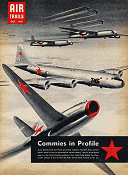 Isn't it interesting how these days you
almost never hear Communists referred to as Communists? Up until the last two decades
or so, newspapers, magazines, television broadcasts, movies, et al, regularly used
the word to describe countries and leaders thereof such as Russia and Soviet Union,
China, Cuba, North Korea, and North Vietnam. I don't think it is because we don't
want to hurt anyone's feelings; rather, it is because the purveyors of the media
are openly simpatico with the precepts, but don't want to bear the stigma of the
title. In 1950 when this "Commies
in Profile" article appeared in Air Trails magazine, no pretenses were
made about who the bad guys were and calling the villain by name was popular. Russia
had been our ally in World War II, but only because we had a common enemy -
the Axis powers. Anyway, here is a collection of known aircraft in the Russian air
force in the time between WWII and Korea. The similarity to many American, British,
and German planes is obvious. The most interesting, IMHO, is the MIG Utka (duck)
canard design... Isn't it interesting how these days you
almost never hear Communists referred to as Communists? Up until the last two decades
or so, newspapers, magazines, television broadcasts, movies, et al, regularly used
the word to describe countries and leaders thereof such as Russia and Soviet Union,
China, Cuba, North Korea, and North Vietnam. I don't think it is because we don't
want to hurt anyone's feelings; rather, it is because the purveyors of the media
are openly simpatico with the precepts, but don't want to bear the stigma of the
title. In 1950 when this "Commies
in Profile" article appeared in Air Trails magazine, no pretenses were
made about who the bad guys were and calling the villain by name was popular. Russia
had been our ally in World War II, but only because we had a common enemy -
the Axis powers. Anyway, here is a collection of known aircraft in the Russian air
force in the time between WWII and Korea. The similarity to many American, British,
and German planes is obvious. The most interesting, IMHO, is the MIG Utka (duck)
canard design...
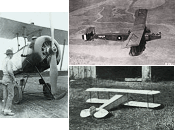 A couple weeks ago I published an article on
my RFCafe.com engineering website titled, "Amazing Collection of QSL Cards and Photographs
from 1924-1978." If you are an amateur radio operator, you will probably want to
take a look at the absolutely huge collection (>5,000) of QSL cards collected
over many decades by Mr. Thomas "Tom" Russell Gentry (W5RG). I mention the website
here as well because there is an equally amazing collection of post World War I
through pre World War II airplane photographs that have most likely never been
seen anywhere else. There are hundreds of biplanes and pilots and hangars and engines
and officers and aerial reconnaissance views, and a whole lot more. Many show the
result of a botched landing or ground loop. There is even a photo of a model biplane
sitting in the grass in front of a hangar. To see all the airplane photographs,
go to the main website and click on the Army Air Corps link at the top. This could
be just what you have been looking for to get authentication photos for your scale
model... A couple weeks ago I published an article on
my RFCafe.com engineering website titled, "Amazing Collection of QSL Cards and Photographs
from 1924-1978." If you are an amateur radio operator, you will probably want to
take a look at the absolutely huge collection (>5,000) of QSL cards collected
over many decades by Mr. Thomas "Tom" Russell Gentry (W5RG). I mention the website
here as well because there is an equally amazing collection of post World War I
through pre World War II airplane photographs that have most likely never been
seen anywhere else. There are hundreds of biplanes and pilots and hangars and engines
and officers and aerial reconnaissance views, and a whole lot more. Many show the
result of a botched landing or ground loop. There is even a photo of a model biplane
sitting in the grass in front of a hangar. To see all the airplane photographs,
go to the main website and click on the Army Air Corps link at the top. This could
be just what you have been looking for to get authentication photos for your scale
model...
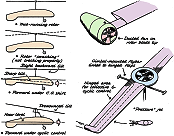 We modelers really have an easy time of
it these days if there is a much stronger desire to fly than to build, or if there
is an innate inability to build well. Levels of engineering and prefabrication have
reached the point that even with vehicles as complex and inherently unstable as
helicopters
and multirotor platforms, a model pilot wannabe can purchase just about any
flying platform in a ready-to-fly configuration. Not many people back in the era
when Roy Clough wrote this article even dreamed that for a couple hundred bucks
it would be possible to buy a helicopter that would be able fly in a hands-off manner,
but would even have an onboard computer that would bring the craft back to an upright,
stable, hovering state simply by pushing a literal panic button on a transmitter.
The state of the art in R/C helicopters was presented in this 1953 issue of
Air Trails magazine... We modelers really have an easy time of
it these days if there is a much stronger desire to fly than to build, or if there
is an innate inability to build well. Levels of engineering and prefabrication have
reached the point that even with vehicles as complex and inherently unstable as
helicopters
and multirotor platforms, a model pilot wannabe can purchase just about any
flying platform in a ready-to-fly configuration. Not many people back in the era
when Roy Clough wrote this article even dreamed that for a couple hundred bucks
it would be possible to buy a helicopter that would be able fly in a hands-off manner,
but would even have an onboard computer that would bring the craft back to an upright,
stable, hovering state simply by pushing a literal panic button on a transmitter.
The state of the art in R/C helicopters was presented in this 1953 issue of
Air Trails magazine...
 Just as with model helicopters, there was
a time not so very long ago (relative to the age of the Earth, anyway) that if you
wanted a
ducted
fan propulsion unit for your model jet aircraft, you had to design and build
it yourself. As usual, the pioneers of the hobby took the figurative arrows for
those of us who would follow in their painfully forged path. Renowned British aeromodeler
P.E. Norman wrote a series of three articles for American Modeler in 1962 detailing
his method of building ducted fan models - including the ducted fan itself. This
third and last installment includes plans for a semi-scale Rapier jet fighter. There
are few people today who would undertake to build the ducted fan unit from scratch
since much more powerful, efficient products are available today, but there are
some lessons to be learned by reading the history of ducted fan development... Just as with model helicopters, there was
a time not so very long ago (relative to the age of the Earth, anyway) that if you
wanted a
ducted
fan propulsion unit for your model jet aircraft, you had to design and build
it yourself. As usual, the pioneers of the hobby took the figurative arrows for
those of us who would follow in their painfully forged path. Renowned British aeromodeler
P.E. Norman wrote a series of three articles for American Modeler in 1962 detailing
his method of building ducted fan models - including the ducted fan itself. This
third and last installment includes plans for a semi-scale Rapier jet fighter. There
are few people today who would undertake to build the ducted fan unit from scratch
since much more powerful, efficient products are available today, but there are
some lessons to be learned by reading the history of ducted fan development...
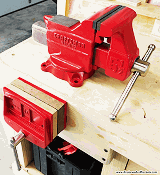 I have been using a 4½" bench vise for decades,
and have always wanted to get a larger one. It was OK for most jobs, but there have
been times when I thought for sure I'd break it when hammering or bending metal
parts in it. This
Craftsman 5½" Bench Vise (Model No. 113.228162) appeared on eBay and looked
to be in pretty good condition. I figured a bit of polishing and painting would
restore it to nearly good-as-new. The vise was taken completely apart and all the
paint was removed using a high speed grinder with an abrasive pad. It left the metal
unscathed. Areas that could not be reached with the grinder were wire brushed. Unpainted
metal parts were polished with a fine grit pad. A thin coat of RustOleum primer
was applied, then three coats of gloss red over that. The vise was set in the sun
all day to cure. A thin layer of grease was put on the swivel base mating surfaces,
jaw screw, and where the handle meets the vise jaw... I have been using a 4½" bench vise for decades,
and have always wanted to get a larger one. It was OK for most jobs, but there have
been times when I thought for sure I'd break it when hammering or bending metal
parts in it. This
Craftsman 5½" Bench Vise (Model No. 113.228162) appeared on eBay and looked
to be in pretty good condition. I figured a bit of polishing and painting would
restore it to nearly good-as-new. The vise was taken completely apart and all the
paint was removed using a high speed grinder with an abrasive pad. It left the metal
unscathed. Areas that could not be reached with the grinder were wire brushed. Unpainted
metal parts were polished with a fine grit pad. A thin coat of RustOleum primer
was applied, then three coats of gloss red over that. The vise was set in the sun
all day to cure. A thin layer of grease was put on the swivel base mating surfaces,
jaw screw, and where the handle meets the vise jaw...
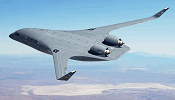 "Initial flight tests of a
blended wing body aircraft could take off in 2027 following JetZero's selection
by the US Department of the Air Force to build a full-scale demonstrator. With a
design that differs from a traditional tube-and-wing aircraft, the blended wing
body (BWB) merges the aircraft body into its high-aspect-ratio wing, decreasing
aerodynamic drag by at least 30% and providing additional lift. This increased efficiency
will enable extended range, more loiter time, and increased payload delivery efficiencies.
'Blended wing body aircraft have the potential to significantly reduce fuel demand
and increase global reach,' said secretary of the Air Force, Frank Kendall. 'Moving
forces and cargo quickly, efficiently, and over long distance is a critical capability
to enable national security strategy..." "Initial flight tests of a
blended wing body aircraft could take off in 2027 following JetZero's selection
by the US Department of the Air Force to build a full-scale demonstrator. With a
design that differs from a traditional tube-and-wing aircraft, the blended wing
body (BWB) merges the aircraft body into its high-aspect-ratio wing, decreasing
aerodynamic drag by at least 30% and providing additional lift. This increased efficiency
will enable extended range, more loiter time, and increased payload delivery efficiencies.
'Blended wing body aircraft have the potential to significantly reduce fuel demand
and increase global reach,' said secretary of the Air Force, Frank Kendall. 'Moving
forces and cargo quickly, efficiently, and over long distance is a critical capability
to enable national security strategy..."
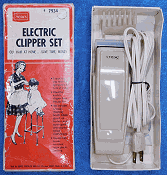 In my zeal to procure some of the items
I remember having or using as a kid in the 1960s and '70s, along with some of the
things Melanie and I had when we first got married back in 1983, I ran across this
Sears Electric Clipper Set
(#7934) on eBay. The seller was only asking about $10 for it, so here it is. As
you can see in the photos, it is in mint condition, and even the original box shows
only minor wear and tear from sitting in someone's closet for more than half a century.
I disassembled the clippers and did a thorough cleaning (not much there) and oiled
the moving parts with a bit of 3-in-1. Everything seems to be in great condition.
Even the power cord is supple and unscathed. One of the plastic blade attachments
was included, although the instruction sheet shows four types. Judging from other
similar clippers for sale on eBay, the set only came with one, and the other styles
must have been available for purchase separately. If you have any you can bear to
part with, please let me know... In my zeal to procure some of the items
I remember having or using as a kid in the 1960s and '70s, along with some of the
things Melanie and I had when we first got married back in 1983, I ran across this
Sears Electric Clipper Set
(#7934) on eBay. The seller was only asking about $10 for it, so here it is. As
you can see in the photos, it is in mint condition, and even the original box shows
only minor wear and tear from sitting in someone's closet for more than half a century.
I disassembled the clippers and did a thorough cleaning (not much there) and oiled
the moving parts with a bit of 3-in-1. Everything seems to be in great condition.
Even the power cord is supple and unscathed. One of the plastic blade attachments
was included, although the instruction sheet shows four types. Judging from other
similar clippers for sale on eBay, the set only came with one, and the other styles
must have been available for purchase separately. If you have any you can bear to
part with, please let me know...
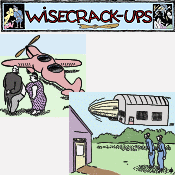 It was May 6, 1937, just a couple months
after this comic appeared in the March 1937 issue of Flying Aces' "Wisecrack-ups"
feature, that the namesake of the alluded-to dirigible would suffer a fiery end
to its service in ferrying passengers back and forth across the Atlantic Ocean.
Prior to that, big plans were in the works for making fortunes on luxury travel
in the relative safety of a large, inherently stable - and presumably safe - mode
of transcontinental travel. Even a switch from highly flammable hydrogen to inert
helium was not enough to assuage the flying public's concerns. Besides, helium was
rather scarce and therefore expensive at the time. The other comic is rather funny,
given the fuselages of both the aeroplane its presumptive passengers. Otherwise,
a collection of puns, jokes, and humorous conversations are included. Some of the
content's impact will be lost on a younger generation not familiar with the situational
circumstances of the era. Enjoy! It was May 6, 1937, just a couple months
after this comic appeared in the March 1937 issue of Flying Aces' "Wisecrack-ups"
feature, that the namesake of the alluded-to dirigible would suffer a fiery end
to its service in ferrying passengers back and forth across the Atlantic Ocean.
Prior to that, big plans were in the works for making fortunes on luxury travel
in the relative safety of a large, inherently stable - and presumably safe - mode
of transcontinental travel. Even a switch from highly flammable hydrogen to inert
helium was not enough to assuage the flying public's concerns. Besides, helium was
rather scarce and therefore expensive at the time. The other comic is rather funny,
given the fuselages of both the aeroplane its presumptive passengers. Otherwise,
a collection of puns, jokes, and humorous conversations are included. Some of the
content's impact will be lost on a younger generation not familiar with the situational
circumstances of the era. Enjoy!
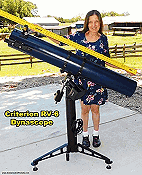 A few years back, I wrote about the
Criterion RV−6 Dynascope, 6" Newtonian telescope I attempted to buy whilst serving
in the USAF at Robins AFB, Georgia, in from 1979-82. Now, half a decade later, I
finally found one at a reasonable price, where the owner was willing to pack and
ship it. He did an excellent job with it, and even used a heavy cardboard SonoTube
for protecting the optical tube. After performing a quick mirror alignment and using
the original Criterion eyepieces, I looked at the moon and Saturn and was amazed
at the quality of the image. A pert−near polar alignment was done and the clock
drive was turned on. With Sirius centered in the eyepiece to begin with, it was
still well within the field of view 20 minutes later. Since completing the restoration,
I did another quickie collimation and took the Criterion RV−6 Dynascope out at night
for a test drive. All I have for eyepieces right now are the original 9 mm
and 18 mm focal length jobs. Beginning with the 18 mm, I found Jupiter
and the four Galilean moons, and Saturn along with Titan. They were in very sharp
focus. Changing to the 9 mm yielded amazingly good images - about as good as
I remember seeing through my Celestron CPC−800 telescope. I then put the 18 mm
in the 2x Barlow lens and found the images.. A few years back, I wrote about the
Criterion RV−6 Dynascope, 6" Newtonian telescope I attempted to buy whilst serving
in the USAF at Robins AFB, Georgia, in from 1979-82. Now, half a decade later, I
finally found one at a reasonable price, where the owner was willing to pack and
ship it. He did an excellent job with it, and even used a heavy cardboard SonoTube
for protecting the optical tube. After performing a quick mirror alignment and using
the original Criterion eyepieces, I looked at the moon and Saturn and was amazed
at the quality of the image. A pert−near polar alignment was done and the clock
drive was turned on. With Sirius centered in the eyepiece to begin with, it was
still well within the field of view 20 minutes later. Since completing the restoration,
I did another quickie collimation and took the Criterion RV−6 Dynascope out at night
for a test drive. All I have for eyepieces right now are the original 9 mm
and 18 mm focal length jobs. Beginning with the 18 mm, I found Jupiter
and the four Galilean moons, and Saturn along with Titan. They were in very sharp
focus. Changing to the 9 mm yielded amazingly good images - about as good as
I remember seeing through my Celestron CPC−800 telescope. I then put the 18 mm
in the 2x Barlow lens and found the images..
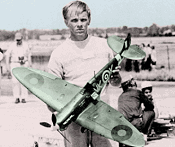 Website visitor Garry O. wrote to request
that I post this article from the December 1972 issue of American Aircraft Modeler
magazine featuring the
Vickers-Supermarine
Spitfire Mk IIA. With its elliptical wing planform and outward-retracting
landing gear, is considered one of the most attractive airplanes ever to come out
of England. It, along with the North American Mustang, are probably the two most
modeled fighters from World War II. This .61-powered control-line model by Malvin
Meador won the 1971 Nationals for control-line scale. It has operating retractable
gear, flaps, sliding canopy, navigation lights, and drop tanks... Website visitor Garry O. wrote to request
that I post this article from the December 1972 issue of American Aircraft Modeler
magazine featuring the
Vickers-Supermarine
Spitfire Mk IIA. With its elliptical wing planform and outward-retracting
landing gear, is considered one of the most attractive airplanes ever to come out
of England. It, along with the North American Mustang, are probably the two most
modeled fighters from World War II. This .61-powered control-line model by Malvin
Meador won the 1971 Nationals for control-line scale. It has operating retractable
gear, flaps, sliding canopy, navigation lights, and drop tanks...
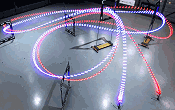 "Drone
racing has joined the list of activities where AI beats humans - in multiple
races against three world-class humans in this case - following research at the
University of Zurich and Intel. 'Physical sports are more challenging for AI because
they are less predictable than board or video games,- said Zurich head of robotics
and perception Davide Scaramuzza. 'We don't have a perfect knowledge of the drone
and environment models, so the AI needs to learn them by interacting with the physical
world.' The sport is FPV (first person view) racing, where humans wearing VR headsets
control their drones using images from on-board cameras..." "Drone
racing has joined the list of activities where AI beats humans - in multiple
races against three world-class humans in this case - following research at the
University of Zurich and Intel. 'Physical sports are more challenging for AI because
they are less predictable than board or video games,- said Zurich head of robotics
and perception Davide Scaramuzza. 'We don't have a perfect knowledge of the drone
and environment models, so the AI needs to learn them by interacting with the physical
world.' The sport is FPV (first person view) racing, where humans wearing VR headsets
control their drones using images from on-board cameras..."
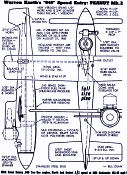 This plan sheet for
Warren Kurth's "049" Speed Entry, Peanut Mk.2, was printed in the October 1961
issue of American Modeler magazine. It won the ½A control line speed event
with an official speed of 102.46 mph. As was common in the day, a bottom fuselage
"pan" made of cast magnesium was used. Speed models had no landing gear and took
off from a drop-away wheeled cradle (I have seen a rear bird or two with a single
embedded wheel). They usually flew from paved or concrete runways (flying circles),
so a metal fuselage made for a durable shell. It also made for a very rigid wing
and tail mount. Metal working skill was/is needed for speed models for modifying
the metal pans to accept the engine, fuel tank, control system, and other construction
components... This plan sheet for
Warren Kurth's "049" Speed Entry, Peanut Mk.2, was printed in the October 1961
issue of American Modeler magazine. It won the ½A control line speed event
with an official speed of 102.46 mph. As was common in the day, a bottom fuselage
"pan" made of cast magnesium was used. Speed models had no landing gear and took
off from a drop-away wheeled cradle (I have seen a rear bird or two with a single
embedded wheel). They usually flew from paved or concrete runways (flying circles),
so a metal fuselage made for a durable shell. It also made for a very rigid wing
and tail mount. Metal working skill was/is needed for speed models for modifying
the metal pans to accept the engine, fuel tank, control system, and other construction
components...
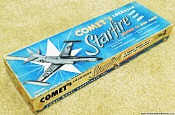 This vintage
Jetex-Powered
Comet Lockheed F−94C Starfire kit (Kit No. SP−1) has been started by the previous
owner. It was designed and drawn by Gerald Blumenthal. The copyright date printed
on the plans is 1953. Many of the parts had been cut out of the printwood balsa
sheets, but none of the airframe has been assembled. I have not done a full inventory
of the kit, but it appears most, if not all, parts are present. The vacuum-formed
plastic components are a bit deformed and discolored from sitting in the box for
many decades, but are useable. A unique feature is the way the landing gear legs
are assembled out of a hardwood dowel for the main strut with music wire protruding
from the bottom for attaching the wooden wheel. One of the gears is already built.
Details are provided for the installation of a Jetex 150 engine with the augmenter
tube. This is a very rare kit... This vintage
Jetex-Powered
Comet Lockheed F−94C Starfire kit (Kit No. SP−1) has been started by the previous
owner. It was designed and drawn by Gerald Blumenthal. The copyright date printed
on the plans is 1953. Many of the parts had been cut out of the printwood balsa
sheets, but none of the airframe has been assembled. I have not done a full inventory
of the kit, but it appears most, if not all, parts are present. The vacuum-formed
plastic components are a bit deformed and discolored from sitting in the box for
many decades, but are useable. A unique feature is the way the landing gear legs
are assembled out of a hardwood dowel for the main strut with music wire protruding
from the bottom for attaching the wooden wheel. One of the gears is already built.
Details are provided for the installation of a Jetex 150 engine with the augmenter
tube. This is a very rare kit...


Website visitor Christian H. for buying my Estes Alpha II rocket kit.
He and his son built it and sent this photo - nice job! The original
Astron (Estes) Alpha kit, as can be seen in the
photos, had balsa fins and nose cone. The fins were cut from sheet balsa and needed
to be glued individually to the body tube. Then, both the nose cone and fins needed
to be coated with filler and sanded before painting. I wonder whether the new model,
which uses lightweight plastic and does not require painting, is lighter than the
original?
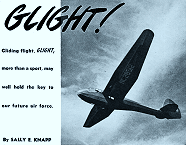 Gliders (aka sailplanes) have always attracted
me because of their
sleek
lines and graceful, silent flight. As a sailboat requires its pilot to possess
a knowledge of how to exploit properties of air currents to propel his water craft,
so, too, must a glider pilot know how to interpret and predict air currents to enable
long flights of his aircraft. As an enthusiast and practitioner of both model and
full-size boats and airplanes (many moons ago), I have great appreciation for both
motor-powered and nature-powered versions, but given a choice between the two, I'll
take the sailplane and the sailboat most of the time. It was not until materials
science was able to produce spars and skins strong and light enough for enabling
high aspect ratio wings that glider transformed from pudgy and boxy to lean and
highly aerodynamic. High performance sailplanes can achieve greater than 40:1 glide
ratios, meaning 40,000 feet (7½ miles) horizontally for every 1,000 feet of altitude
lost (in neutral air). In 1945 when this "Glight!" article appeared in Flying Age
magazine, the aforementioned materials discoveries had either not yet been made
or not yet applied to glider airframes, as can be seen in these photos... Gliders (aka sailplanes) have always attracted
me because of their
sleek
lines and graceful, silent flight. As a sailboat requires its pilot to possess
a knowledge of how to exploit properties of air currents to propel his water craft,
so, too, must a glider pilot know how to interpret and predict air currents to enable
long flights of his aircraft. As an enthusiast and practitioner of both model and
full-size boats and airplanes (many moons ago), I have great appreciation for both
motor-powered and nature-powered versions, but given a choice between the two, I'll
take the sailplane and the sailboat most of the time. It was not until materials
science was able to produce spars and skins strong and light enough for enabling
high aspect ratio wings that glider transformed from pudgy and boxy to lean and
highly aerodynamic. High performance sailplanes can achieve greater than 40:1 glide
ratios, meaning 40,000 feet (7½ miles) horizontally for every 1,000 feet of altitude
lost (in neutral air). In 1945 when this "Glight!" article appeared in Flying Age
magazine, the aforementioned materials discoveries had either not yet been made
or not yet applied to glider airframes, as can be seen in these photos...
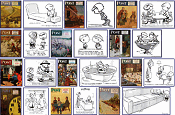 The
Peanuts© comic strip,
drawn by Charles Schulz, has been my lifetime favorite. That it is also the world's
favorite strip is no wonder. Now that I have crossed the half-century threshold,
I tend to look back at the innocence and complexity of the themes with a perspective
other than simply entertainment - although I still thoroughly enjoy reading them
just to get a few good laughs. Since Charles Schulz's death in 2000, books have
been published documenting his life and how his experiences influenced Peanuts characters'
appearances and behaviors. It is apparent from the content that Mr. Schulz hearkened
from an era much different from today. It is hard to imagine a start-up comic akin
to Peanuts being accepted in the much cruder, meaner, and less polite world of 2009.
One interesting tidbit that I found in Peanuts: The Art of Charles M. Schulz, is
a list of the edition of The Saturday Evening Post where Schulz's first for-pay
comics appeared... The
Peanuts© comic strip,
drawn by Charles Schulz, has been my lifetime favorite. That it is also the world's
favorite strip is no wonder. Now that I have crossed the half-century threshold,
I tend to look back at the innocence and complexity of the themes with a perspective
other than simply entertainment - although I still thoroughly enjoy reading them
just to get a few good laughs. Since Charles Schulz's death in 2000, books have
been published documenting his life and how his experiences influenced Peanuts characters'
appearances and behaviors. It is apparent from the content that Mr. Schulz hearkened
from an era much different from today. It is hard to imagine a start-up comic akin
to Peanuts being accepted in the much cruder, meaner, and less polite world of 2009.
One interesting tidbit that I found in Peanuts: The Art of Charles M. Schulz, is
a list of the edition of The Saturday Evening Post where Schulz's first for-pay
comics appeared...
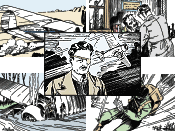 In the 1930s, Flying Aces magazine
ran a series highlighting aviation pioneers and heros called "They Had What It Takes."
The March 1937 issue featured
Wiley
Post. He was famous for being the first man to circumnavigate the globe alone,
but what really set him apart from other trail blazers was his having only one good
eye. Mr. Post lost use of his left eye due to a metal shaving being thrown
into it during a drilling procedure. He used the workman's compensation award to
buy a Curtiss Jenney biplane, thus beginning his flying career. The FAA will issue
special waivers for what is termed "monocular vision," when the corrected visual
acuity in the worst eye is less than 20/200. Stereo vision (stereopsis) is considered
lost at that point, but stereo vision is only effective a distances up to about
100 feet, so long distance depth perception is a matter of familiarity with how
objects of known size would appear at various distances... In the 1930s, Flying Aces magazine
ran a series highlighting aviation pioneers and heros called "They Had What It Takes."
The March 1937 issue featured
Wiley
Post. He was famous for being the first man to circumnavigate the globe alone,
but what really set him apart from other trail blazers was his having only one good
eye. Mr. Post lost use of his left eye due to a metal shaving being thrown
into it during a drilling procedure. He used the workman's compensation award to
buy a Curtiss Jenney biplane, thus beginning his flying career. The FAA will issue
special waivers for what is termed "monocular vision," when the corrected visual
acuity in the worst eye is less than 20/200. Stereo vision (stereopsis) is considered
lost at that point, but stereo vision is only effective a distances up to about
100 feet, so long distance depth perception is a matter of familiarity with how
objects of known size would appear at various distances...
 Finding poetry, short stories, and even
songs
in magazines was common up until sometime in the 1970s. I'm not sure why it stopped
(or nearly so), but as a reader of many vintage magazine types - airplanes, woodworking,
mechanics, electronics, and others - I can attest to it. Both here on Airplanes
and Rockets and on my RF Cafe engineering website, I have posted quite a few examples.
Here is yet another from the July/August 1963 edition of American Modeler
magazine. As time goes by, I wonder how many of today's readers are even familiar
with some of the tunes the songs are meant to follow... Finding poetry, short stories, and even
songs
in magazines was common up until sometime in the 1970s. I'm not sure why it stopped
(or nearly so), but as a reader of many vintage magazine types - airplanes, woodworking,
mechanics, electronics, and others - I can attest to it. Both here on Airplanes
and Rockets and on my RF Cafe engineering website, I have posted quite a few examples.
Here is yet another from the July/August 1963 edition of American Modeler
magazine. As time goes by, I wonder how many of today's readers are even familiar
with some of the tunes the songs are meant to follow...
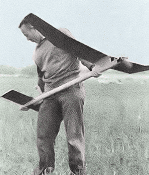 Being risk averse by nature, I have always
shied away from "serious"
free
flight for fear of losing a model to a passing thermal or an unobserved wind
carrying a model into the hinterlands or into the tops of trees. Having at least
control of the rudder to make the ship turn around as necessary always seems the
prudent approach. Still, there are thousands of daredevils who willingly risk all
for the chance to set a new personal record and/or practice for a competition, relying
on a dethermalizer and a lot of skill to stave off disaster. They surely are a hardy
bunch. This "No Strings Attached" column from the May/June 1963 edition of American
Modeler magazine reports on "Lucky" Bill Hartill, whose FF ship was whisked
away by one of those aforementioned thermals, deemed lost forever, and then a few
hours later found and returned by a farmer who saw it landing in his field 8 miles
away. That's just one of many instances, evidently, where "Lucky" earned his nickname... Being risk averse by nature, I have always
shied away from "serious"
free
flight for fear of losing a model to a passing thermal or an unobserved wind
carrying a model into the hinterlands or into the tops of trees. Having at least
control of the rudder to make the ship turn around as necessary always seems the
prudent approach. Still, there are thousands of daredevils who willingly risk all
for the chance to set a new personal record and/or practice for a competition, relying
on a dethermalizer and a lot of skill to stave off disaster. They surely are a hardy
bunch. This "No Strings Attached" column from the May/June 1963 edition of American
Modeler magazine reports on "Lucky" Bill Hartill, whose FF ship was whisked
away by one of those aforementioned thermals, deemed lost forever, and then a few
hours later found and returned by a farmer who saw it landing in his field 8 miles
away. That's just one of many instances, evidently, where "Lucky" earned his nickname...
 In 1961 when this
Citizen−Ship LT−3 Relayless Receiver promotion appeared in American Modeler
magazine, transistorized circuits were a relatively new thing. Many people were
dubious of the newfangled technology and were leery of the dependability of them.
It didn't take long for the convenience of low weight, small size, higher functionality,
and no need for bulky and heavy high voltage batteries to sway even the most hard
cord tubeist (a word I just made up) toward adopting the format. Even so, the state
of the art had a long way to go to get anywhere close to today's micro- and nano-sized
receivers and servos, with capabilities and reliability levels only dreamed of in
1961. The escapement mechanism featured was powered by a twisted rubber band. A
pulse of current from the receiver caused the control arms to rotate a quarter turn
when a small solenoid released the escapement tab. So, although the receiver itself
was "relayless," the escapement still had one (a relay is a solenoid with make/break
electrical contacts)... In 1961 when this
Citizen−Ship LT−3 Relayless Receiver promotion appeared in American Modeler
magazine, transistorized circuits were a relatively new thing. Many people were
dubious of the newfangled technology and were leery of the dependability of them.
It didn't take long for the convenience of low weight, small size, higher functionality,
and no need for bulky and heavy high voltage batteries to sway even the most hard
cord tubeist (a word I just made up) toward adopting the format. Even so, the state
of the art had a long way to go to get anywhere close to today's micro- and nano-sized
receivers and servos, with capabilities and reliability levels only dreamed of in
1961. The escapement mechanism featured was powered by a twisted rubber band. A
pulse of current from the receiver caused the control arms to rotate a quarter turn
when a small solenoid released the escapement tab. So, although the receiver itself
was "relayless," the escapement still had one (a relay is a solenoid with make/break
electrical contacts)...
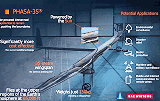 "A solar-powered drone built by BAE Warton,
described as a High Altitude Pseudo Satellite (HAPS) Unmanned Aerial System (UAS)
has reached 66,000 feet on its 24 hour maiden flight in New Mexico. The drone, called
PHASA-35, has a 115 foot wingspan, weighs 150 kg and is powered by batteries
at night allowing it to be airborne for several months. It can carry a load of 15 kg
(33 lbs.) and applications are seen as environmental surveillance, disaster relief,
border protection, maritime and military surveillance, and mobile Internet communications.
'It is the first in a series of trials planned to confirm system performance, support
development activities and validate test points to enable
PHASA-35 to be made available in defence and commercial markets internationally..." "A solar-powered drone built by BAE Warton,
described as a High Altitude Pseudo Satellite (HAPS) Unmanned Aerial System (UAS)
has reached 66,000 feet on its 24 hour maiden flight in New Mexico. The drone, called
PHASA-35, has a 115 foot wingspan, weighs 150 kg and is powered by batteries
at night allowing it to be airborne for several months. It can carry a load of 15 kg
(33 lbs.) and applications are seen as environmental surveillance, disaster relief,
border protection, maritime and military surveillance, and mobile Internet communications.
'It is the first in a series of trials planned to confirm system performance, support
development activities and validate test points to enable
PHASA-35 to be made available in defence and commercial markets internationally..."
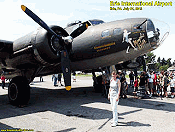 On July 21, 2013, Melanie and I toured the
inside of the "Memphis Belle"
that was used in filming the movie of the same name. North Coast Air, based at Erie
International Airport, hosted the event. This particular B−17 Flying Fortress is
not the original Memphis Belle, but is a version that was produced in 1945, near
the end of World War II. It is being leased by the Liberty Foundation
for country-wide public tours while the ill-fated Liberty Belle is being restored.
Rides were being offered for around $500 per seat, so we had to pass on that. I'd
gladly pay the price if we could afford it, because the costs of operating such
an aircraft is enormous. Fortunately, wealthy sponsors pay for the majority of the
expenses. The Smithsonian of course has a fully restored B−17, but it sits in a
museum and never takes to the air. The B−17's four Pratt & Whitney R-1690 Hornet
radial engines make an unmistakable sound in the air, as do other multi-engine World
War II era planes. I still run outside the house an search the skies when I
hear such a sweet noise.. On July 21, 2013, Melanie and I toured the
inside of the "Memphis Belle"
that was used in filming the movie of the same name. North Coast Air, based at Erie
International Airport, hosted the event. This particular B−17 Flying Fortress is
not the original Memphis Belle, but is a version that was produced in 1945, near
the end of World War II. It is being leased by the Liberty Foundation
for country-wide public tours while the ill-fated Liberty Belle is being restored.
Rides were being offered for around $500 per seat, so we had to pass on that. I'd
gladly pay the price if we could afford it, because the costs of operating such
an aircraft is enormous. Fortunately, wealthy sponsors pay for the majority of the
expenses. The Smithsonian of course has a fully restored B−17, but it sits in a
museum and never takes to the air. The B−17's four Pratt & Whitney R-1690 Hornet
radial engines make an unmistakable sound in the air, as do other multi-engine World
War II era planes. I still run outside the house an search the skies when I
hear such a sweet noise..
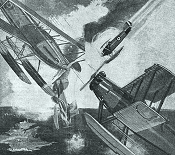 Some of the adventure stories in Flying
Aces magazine were practically full-length novels. The May 1934 issue included
one of Donald Keyhoe's pieces entitled, "Death
Flies the Equator," featuring intrepid G−2 agent, Dick Knight, and his sidekick,
Lothario Doyle, who team up to pit good against evil across the globe. The notorious
"Four Faces" cabal fixed on achieving world domination are a constant challenge
for the wits and wile of our heroic pair. Dick Knight supplies the brunt of required
brainwork while ex-Marine Doyle breaks bones and faces when needed. Both are accomplished
airborne dogfighters, avigators (archaic term for aviator / navigator), and mechanics.
Many of these stories involve fantastic weapons and deception devices, sabotage,
moles, traitors, and incredible feats of flying. They really are "page-turners,"
and the only things that keeps me from reading straight through is wanting to be
able to spread the entertainment across the span of several night's reading in bed.
Unlike most magazines of yesterday and today, Flying Aces usually... Some of the adventure stories in Flying
Aces magazine were practically full-length novels. The May 1934 issue included
one of Donald Keyhoe's pieces entitled, "Death
Flies the Equator," featuring intrepid G−2 agent, Dick Knight, and his sidekick,
Lothario Doyle, who team up to pit good against evil across the globe. The notorious
"Four Faces" cabal fixed on achieving world domination are a constant challenge
for the wits and wile of our heroic pair. Dick Knight supplies the brunt of required
brainwork while ex-Marine Doyle breaks bones and faces when needed. Both are accomplished
airborne dogfighters, avigators (archaic term for aviator / navigator), and mechanics.
Many of these stories involve fantastic weapons and deception devices, sabotage,
moles, traitors, and incredible feats of flying. They really are "page-turners,"
and the only things that keeps me from reading straight through is wanting to be
able to spread the entertainment across the span of several night's reading in bed.
Unlike most magazines of yesterday and today, Flying Aces usually...
 "Are you ready for this year's
NASA TechRise Student Challenge?
From researching Earth's environment to designing experiments for lunar and planetary
exploration, schools are invited to join NASA in its mission to inspire the world
through discovery. If you are in sixth to 12th grade at a U.S. public, private,
or charter school - including those in U.S. territories - your challenge is to team
up with your schoolmates and develop a science or technology experiment idea for
one of the following NASA TechRise flight vehicles: High-Altitude Balloon with approximately
four hours of flight time at 70,000 feet and exposure to Earth's atmosphere, high-altitude
radiation, and perspective views of our planet Rocket-Powered Lander that will fly
for approximately two minutes at an altitude of 80 ft (~25 m) over a test
field designed to look like the Moon's surface..." "Are you ready for this year's
NASA TechRise Student Challenge?
From researching Earth's environment to designing experiments for lunar and planetary
exploration, schools are invited to join NASA in its mission to inspire the world
through discovery. If you are in sixth to 12th grade at a U.S. public, private,
or charter school - including those in U.S. territories - your challenge is to team
up with your schoolmates and develop a science or technology experiment idea for
one of the following NASA TechRise flight vehicles: High-Altitude Balloon with approximately
four hours of flight time at 70,000 feet and exposure to Earth's atmosphere, high-altitude
radiation, and perspective views of our planet Rocket-Powered Lander that will fly
for approximately two minutes at an altitude of 80 ft (~25 m) over a test
field designed to look like the Moon's surface..."
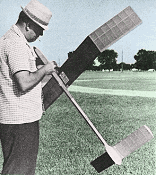 As open space becomes more and more scare
in populated areas all up and down the East Coast, the Great Lakes region, and similar
sections of the country, free flight activities are increasingly difficult to contemplate.
The same goes for model rocketry. All of the fields I used to fly from in the Mayo
(Annapolis), Maryland, area when in my teens back in the early to mid 1970s were
long ago turned into housing developments, commercial office or retail outlet stores.
It used to be a simple matter of loading an airplane or rocket into my 1969 Camaro
and driving a few miles to a school yard or an empty lot behind a strip mall, but
not so much anymore. Even if you do manage to locate a suitable flying area, there
are usually signs posted warning of prosecution for trespassing (often made necessary
due to our overly litigious society). School athletic fields are typically cluttered
with soccer nets and other permanent structures. Whenever I see photos in articles
like this one for a
free flight towed glider model, I am struck by the starkness of the landscape
in the background. It seems today you need to me in a Midwest farm field, in the
High Plains, or Southwest deserts to find ample open areas... As open space becomes more and more scare
in populated areas all up and down the East Coast, the Great Lakes region, and similar
sections of the country, free flight activities are increasingly difficult to contemplate.
The same goes for model rocketry. All of the fields I used to fly from in the Mayo
(Annapolis), Maryland, area when in my teens back in the early to mid 1970s were
long ago turned into housing developments, commercial office or retail outlet stores.
It used to be a simple matter of loading an airplane or rocket into my 1969 Camaro
and driving a few miles to a school yard or an empty lot behind a strip mall, but
not so much anymore. Even if you do manage to locate a suitable flying area, there
are usually signs posted warning of prosecution for trespassing (often made necessary
due to our overly litigious society). School athletic fields are typically cluttered
with soccer nets and other permanent structures. Whenever I see photos in articles
like this one for a
free flight towed glider model, I am struck by the starkness of the landscape
in the background. It seems today you need to me in a Midwest farm field, in the
High Plains, or Southwest deserts to find ample open areas...
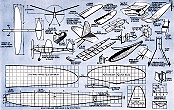 As with most of the handyman's type of magazine
of the era, Popular Science features a very broad array of topics, including
full size and model aeroplanes. The May 1968 issue of Popular Mechanics
had plans for a full-size homebuilt airplane made of spruce and plywood, using a
modified Volkswagen engine. This June 1941 issue had plans for building a
rubber powered free flight model dubbed the "Minute Man." It is a simple stick
and tissue job that can be built for a few pennies worth (at the time) of balsa,
glue, Jap tissue, and rubber (of course in today's hyperinflated Bidenomics world
the price is measured in dollars). Old timers like myself are familiar with the
designer, Frank Zaic. He was the founder of the Academy of Model Aeronautics (AMA)
in 1936, an organization which still thrives today. He was also co-founder of Model
Aviation magazine, which has undergone a myriad of name changes over the years,
and is now back to it's original name. Frank's experience as a draftsman for the
U.S. Patent Office is apparent in the quality of his plans... As with most of the handyman's type of magazine
of the era, Popular Science features a very broad array of topics, including
full size and model aeroplanes. The May 1968 issue of Popular Mechanics
had plans for a full-size homebuilt airplane made of spruce and plywood, using a
modified Volkswagen engine. This June 1941 issue had plans for building a
rubber powered free flight model dubbed the "Minute Man." It is a simple stick
and tissue job that can be built for a few pennies worth (at the time) of balsa,
glue, Jap tissue, and rubber (of course in today's hyperinflated Bidenomics world
the price is measured in dollars). Old timers like myself are familiar with the
designer, Frank Zaic. He was the founder of the Academy of Model Aeronautics (AMA)
in 1936, an organization which still thrives today. He was also co-founder of Model
Aviation magazine, which has undergone a myriad of name changes over the years,
and is now back to it's original name. Frank's experience as a draftsman for the
U.S. Patent Office is apparent in the quality of his plans...
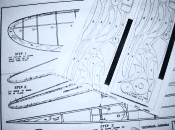 I have received many requests for the scanned
plans file for the Comet Sparky free flight model. Along with the plans, I provide
three files that contain the printwood
patterns. Printwood patterns, for those of you unfamiliar with the term, are
the ink pattern that were printed directly onto the balsa so that the model builder
could cut the pieces out. This was the el cheapo way of producing a kit where the
expense of die cutting was not incurred by the manufacturer. Truth be told, the
die cutting was usually so lousy that you were better off cutting the parts yourself.
Well, it would be if companies like Comet didn't make a habit of using balsa with
about the same density and hardness as oak. Cutting 1/16" square longerons in fuselage
bulkheads or wing spar notches in wing ribs was a real challenge - especially if
you were a kid whose only form of razor sharp tool was a used blade from your father's
razor. By the way, the printwood patterns are necessary because most plans from
kits do not include templates for all of the sheet balsa parts. That is as true
today as it was 50 years ago... I have received many requests for the scanned
plans file for the Comet Sparky free flight model. Along with the plans, I provide
three files that contain the printwood
patterns. Printwood patterns, for those of you unfamiliar with the term, are
the ink pattern that were printed directly onto the balsa so that the model builder
could cut the pieces out. This was the el cheapo way of producing a kit where the
expense of die cutting was not incurred by the manufacturer. Truth be told, the
die cutting was usually so lousy that you were better off cutting the parts yourself.
Well, it would be if companies like Comet didn't make a habit of using balsa with
about the same density and hardness as oak. Cutting 1/16" square longerons in fuselage
bulkheads or wing spar notches in wing ribs was a real challenge - especially if
you were a kid whose only form of razor sharp tool was a used blade from your father's
razor. By the way, the printwood patterns are necessary because most plans from
kits do not include templates for all of the sheet balsa parts. That is as true
today as it was 50 years ago...
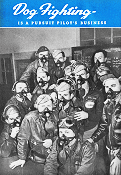 If you think you can imagine, without having
ever done so, what it would be like to be in the cockpit of a fighter plane battling
with an adversary for dear life, you are fooling yourself. The same goes for going
tanque to tanque or mano a mano on the battlefield with opposing
forces. The complex, synergistic combination of fear, adrenalin, honor, patriotism,
self-preservation, revenge, egotism, hatred, rage, camaraderie, esprit de corps,
and other emotions can only be experienced in−person, and nobody knows for certain
how he will react to the circumstance - especially for the first time. Intense training
can help prepare you, but you just don't know until you're there. Although nowhere
as consequential, look at how people freeze with stage fright when facing a large
audience in a big venue for the first time. Aerial combat fighters, aka
dog fighters or pursuit fighters (which is where the "P" comes from in P-51,
P-40, etc.), are the cream of the crop of airmen, going back to the first air-to-air
conflicts of World War I. Yes, ground fighting requires courage and wit, but
adding that third dimension to the equation does not add merely another 50% to the
mix; it multiplies that difficulty by a much larger factor... If you think you can imagine, without having
ever done so, what it would be like to be in the cockpit of a fighter plane battling
with an adversary for dear life, you are fooling yourself. The same goes for going
tanque to tanque or mano a mano on the battlefield with opposing
forces. The complex, synergistic combination of fear, adrenalin, honor, patriotism,
self-preservation, revenge, egotism, hatred, rage, camaraderie, esprit de corps,
and other emotions can only be experienced in−person, and nobody knows for certain
how he will react to the circumstance - especially for the first time. Intense training
can help prepare you, but you just don't know until you're there. Although nowhere
as consequential, look at how people freeze with stage fright when facing a large
audience in a big venue for the first time. Aerial combat fighters, aka
dog fighters or pursuit fighters (which is where the "P" comes from in P-51,
P-40, etc.), are the cream of the crop of airmen, going back to the first air-to-air
conflicts of World War I. Yes, ground fighting requires courage and wit, but
adding that third dimension to the equation does not add merely another 50% to the
mix; it multiplies that difficulty by a much larger factor...
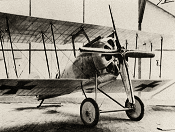 Airplanes and Rockets website visitor Peter
C., of the UK, contacted me about scanning information from a vintage copy of American
Aircraft Modeler magazine. Peter requested the 3-view drawing of the
Pfalz D.III biplane (by
Mr. Björn Karlström) that appeared in the July 1973 edition. I did him one better
by also scanning and OCRing the text of the accompanying article as well. Author
Patricia Groves did a very thorough job of researching the history of the Pfalz
D.III biplane, and included some rarely seen photos of the various versions. Enjoy... Airplanes and Rockets website visitor Peter
C., of the UK, contacted me about scanning information from a vintage copy of American
Aircraft Modeler magazine. Peter requested the 3-view drawing of the
Pfalz D.III biplane (by
Mr. Björn Karlström) that appeared in the July 1973 edition. I did him one better
by also scanning and OCRing the text of the accompanying article as well. Author
Patricia Groves did a very thorough job of researching the history of the Pfalz
D.III biplane, and included some rarely seen photos of the various versions. Enjoy...
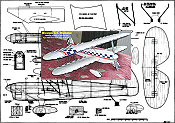 Airplanes and Rockets website visitor Ray
L. wrote to say he has a
Biceps control line
model that appeared in the April 1969 edition of American Aircraft Modeler
magazine, and that he would like to have the article posted. Per Roy, "I bought
this model from one of our club members who is a team race flier and built it on
a whim, he fitted it with electric and had it test flown by one of our aerobatic
pilots and after that he lost interest it and I was happy to give it a good home,
the quality of build and finish is to pro standards." Power in the original was
a Fox .59, wingspan is 48". AMA Plans Service still prints the Biceps plans. Airplanes and Rockets website visitor Ray
L. wrote to say he has a
Biceps control line
model that appeared in the April 1969 edition of American Aircraft Modeler
magazine, and that he would like to have the article posted. Per Roy, "I bought
this model from one of our club members who is a team race flier and built it on
a whim, he fitted it with electric and had it test flown by one of our aerobatic
pilots and after that he lost interest it and I was happy to give it a good home,
the quality of build and finish is to pro standards." Power in the original was
a Fox .59, wingspan is 48". AMA Plans Service still prints the Biceps plans.
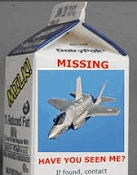 We have
truly fallen as a great country. This weekend, a U.S.
Air Force F-35 stealth jet went missing in South Carolina after its pilot ejected.
Officials claim it just disappeared. A call went out to the public for assistance
in finding it. Yes, you read that right. As with many stories like this on, the
reader comments are the best part. Examples include "It's stealth so you'll never
find it," Look for it in Iran parked next to the supersecret
drone we let
them commandeer in 2011," "It's now flying over Ukraine," "Parked in Joe's garage
next to his 1967 Corvette," "The Mexican aliens snatched it," "It now identifies
as a bird and just flew away," "The official list of Jeffery Epstein Pedo Island
clients was aboard - you'll never find it." Fortunately, the pilot got out safely,
but bailing and saving your own hide out while your aircraft is left to go its own
way and potentially wreak massive damage and death to unwitting targets on the ground
seems undistingushed. We have
truly fallen as a great country. This weekend, a U.S.
Air Force F-35 stealth jet went missing in South Carolina after its pilot ejected.
Officials claim it just disappeared. A call went out to the public for assistance
in finding it. Yes, you read that right. As with many stories like this on, the
reader comments are the best part. Examples include "It's stealth so you'll never
find it," Look for it in Iran parked next to the supersecret
drone we let
them commandeer in 2011," "It's now flying over Ukraine," "Parked in Joe's garage
next to his 1967 Corvette," "The Mexican aliens snatched it," "It now identifies
as a bird and just flew away," "The official list of Jeffery Epstein Pedo Island
clients was aboard - you'll never find it." Fortunately, the pilot got out safely,
but bailing and saving your own hide out while your aircraft is left to go its own
way and potentially wreak massive damage and death to unwitting targets on the ground
seems undistingushed.
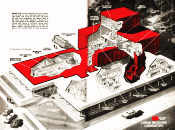 "The
Andromeda Strain" movie came out in 1971, just two years after Michael Crichton's
book of the same name was published. The plot centered around a military satellite
which had returned to earth harboring a deadly microorganism that killed the entire
town of people where it landed. 1969, the year of the book, coincided with when
the first humans, via Apollo 11, were exposed to the environment of another
heavenly body - the moon. "The Andromeda Strain" owed its public intrigue to decades
of stories telling of and wondering about what kinds of deadly living and nonliving
entities might permeate outer space and potentially cause a plague which might end
life on Earth. Although NASA had, by July of 1969, a lot of experience with vehicles
and humans going into space and returning with detectable traces of harmful organisms
or chemicals, it had never dealt with anything that had been exposed to the surface
of another solid body (the moon). Any type of biomass that might have accompanied
a meteorite would have been rendered lifeless as its host projectile burned during
passage through Earth's atmosphere. Apollo 11 astronauts might bring with them
entities protected by the same life-preserving capsule that would keep them alive
during their trip home... "The
Andromeda Strain" movie came out in 1971, just two years after Michael Crichton's
book of the same name was published. The plot centered around a military satellite
which had returned to earth harboring a deadly microorganism that killed the entire
town of people where it landed. 1969, the year of the book, coincided with when
the first humans, via Apollo 11, were exposed to the environment of another
heavenly body - the moon. "The Andromeda Strain" owed its public intrigue to decades
of stories telling of and wondering about what kinds of deadly living and nonliving
entities might permeate outer space and potentially cause a plague which might end
life on Earth. Although NASA had, by July of 1969, a lot of experience with vehicles
and humans going into space and returning with detectable traces of harmful organisms
or chemicals, it had never dealt with anything that had been exposed to the surface
of another solid body (the moon). Any type of biomass that might have accompanied
a meteorite would have been rendered lifeless as its host projectile burned during
passage through Earth's atmosphere. Apollo 11 astronauts might bring with them
entities protected by the same life-preserving capsule that would keep them alive
during their trip home...
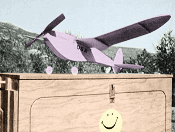 Website visitor Kenneth E. wrote to say
that he is working to build a complete collection of the "For the Tenderfoot" models that
were published in American Aircraft Modeler magazine. The "For the Tenderfoot"
series was an attempt to provide motivation to young newcomers to the hobby. They
were a mix of free flight rubber, gliders, and 1/4A & 1/2A control line designs
that built simply and cheaply. Kenneth requested reprints of the following three
models: Saucerer, Ray Malmström: C/L 1/2A, January 1970 Bonanza and Mustang, David
Thornburg: FF HLG, January 1971 Clodhopper, Paul Denson: FF Rubber February 1973... Website visitor Kenneth E. wrote to say
that he is working to build a complete collection of the "For the Tenderfoot" models that
were published in American Aircraft Modeler magazine. The "For the Tenderfoot"
series was an attempt to provide motivation to young newcomers to the hobby. They
were a mix of free flight rubber, gliders, and 1/4A & 1/2A control line designs
that built simply and cheaply. Kenneth requested reprints of the following three
models: Saucerer, Ray Malmström: C/L 1/2A, January 1970 Bonanza and Mustang, David
Thornburg: FF HLG, January 1971 Clodhopper, Paul Denson: FF Rubber February 1973...
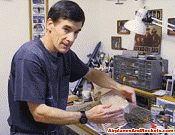 If you do a Google search on
Silkspan and dope covering methods,
a lot of good written instructions can be found. In fact, I suggest you read one
or two of them if you have never done a Silkspan and dope covering job before, or
if it has been a while and you want a refresher course, or if you have tried and
never been able to get an acceptable result. There is no special skill required
to obtain a really nice looking Silkspan and dope finish, there are a couple "gotcha"
scenarios that can ruin an otherwise simple process. I believe the two worst mistakes
you can make are painting dope in air that is too humid, and using a thinner that
is not entirely compatible with the dope (nitrate or butyrate). I decided it might
be a good idea to make a video of how I have been successfully achieving decent
Silkspan and dope finishes for lo these 40 or more years. My finishes have never
won any prizes, but the tissue (Silkspan) has always been nice and taught and the
brushed dope has gone on evenly, with nice, sharp trim lines. The subject of this
tutorial / demonstration is a Sopwith Camel biplane from a Manzano Laser Works kit.
My Camel first flew as a 3-channel radio controlled model, and was covered with
Monokote. It experienced an unplanned encounter with terra firma and broke off half
of the top left wing. Since I had originally planned to build it for control line... If you do a Google search on
Silkspan and dope covering methods,
a lot of good written instructions can be found. In fact, I suggest you read one
or two of them if you have never done a Silkspan and dope covering job before, or
if it has been a while and you want a refresher course, or if you have tried and
never been able to get an acceptable result. There is no special skill required
to obtain a really nice looking Silkspan and dope finish, there are a couple "gotcha"
scenarios that can ruin an otherwise simple process. I believe the two worst mistakes
you can make are painting dope in air that is too humid, and using a thinner that
is not entirely compatible with the dope (nitrate or butyrate). I decided it might
be a good idea to make a video of how I have been successfully achieving decent
Silkspan and dope finishes for lo these 40 or more years. My finishes have never
won any prizes, but the tissue (Silkspan) has always been nice and taught and the
brushed dope has gone on evenly, with nice, sharp trim lines. The subject of this
tutorial / demonstration is a Sopwith Camel biplane from a Manzano Laser Works kit.
My Camel first flew as a 3-channel radio controlled model, and was covered with
Monokote. It experienced an unplanned encounter with terra firma and broke off half
of the top left wing. Since I had originally planned to build it for control line...
 This
propeller extension shaft featured in a 1941 issue of Flying Aces magazine
is an example of a concept that seemed like a good idea on paper, but probably proved
to be a disaster in practice. If you have ever had an R/C helicopter with an even
slightly bent main rotor shaft, then you know how the situation causes vibrations
whose severity varies with the amount of bending and the rotation rate of the shaft.
Helicopter main rotors turn at a fairly low rate compared to an aircraft propeller,
although the mass and diameter of the propeller is much less than a rotor. Even
so, I imagine the vibration caused by even a slightly bent propeller shaft extension
when the engine is running at peak RPM is very high - enough to cause the situation
to quickly get worse. It is a runaway situation where the bend increases, causing
worse vibration, which causes more bending, causing greater vibration, etc., etc.,
etc. An additional problem would be caused by the longer moment arm causing additional
wear on the crankshaft bearings and/or bushings, particularly during abrupt change
in the airplane's pitch angle. The proof that propeller extension shafts were not... This
propeller extension shaft featured in a 1941 issue of Flying Aces magazine
is an example of a concept that seemed like a good idea on paper, but probably proved
to be a disaster in practice. If you have ever had an R/C helicopter with an even
slightly bent main rotor shaft, then you know how the situation causes vibrations
whose severity varies with the amount of bending and the rotation rate of the shaft.
Helicopter main rotors turn at a fairly low rate compared to an aircraft propeller,
although the mass and diameter of the propeller is much less than a rotor. Even
so, I imagine the vibration caused by even a slightly bent propeller shaft extension
when the engine is running at peak RPM is very high - enough to cause the situation
to quickly get worse. It is a runaway situation where the bend increases, causing
worse vibration, which causes more bending, causing greater vibration, etc., etc.,
etc. An additional problem would be caused by the longer moment arm causing additional
wear on the crankshaft bearings and/or bushings, particularly during abrupt change
in the airplane's pitch angle. The proof that propeller extension shafts were not...
|